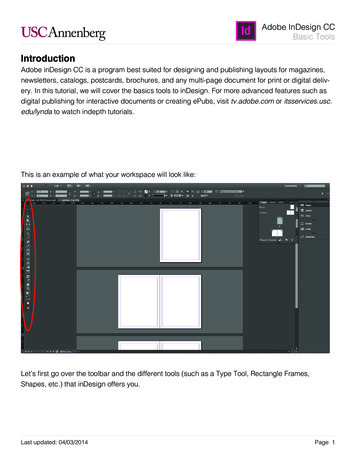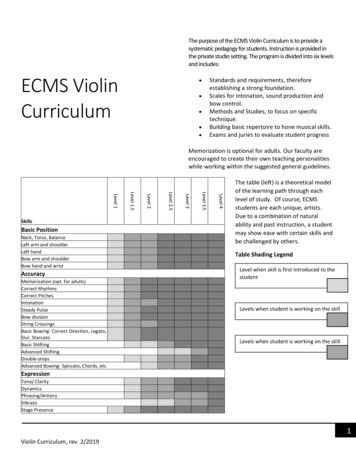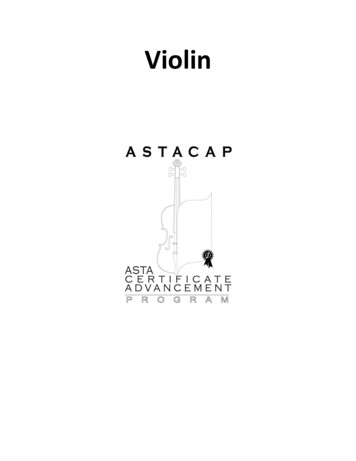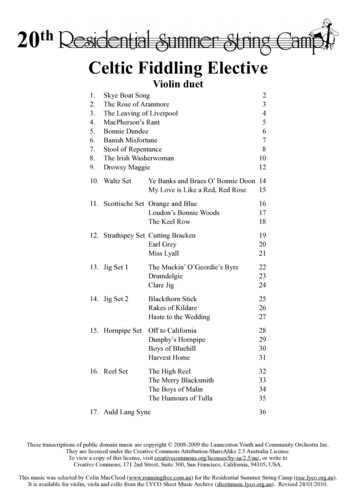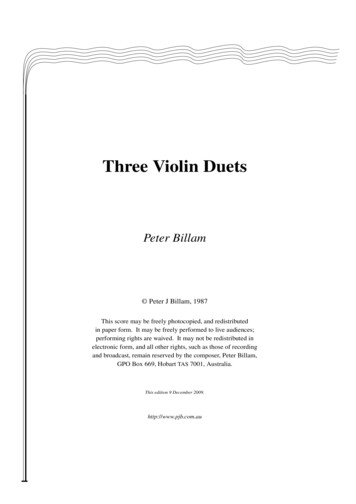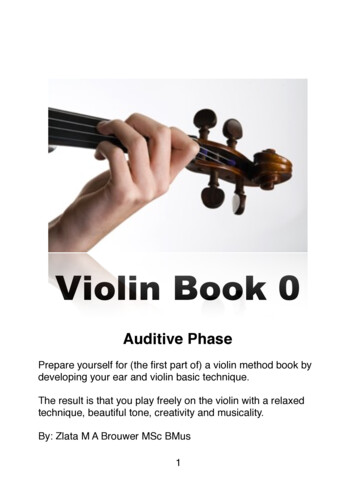
Transcription
Violin Book 0Auditive PhasePrepare yourself for (the first part of) a violin method book bydeveloping your ear and violin basic technique.The result is that you play freely on the violin with a relaxedtechnique, beautiful tone, creativity and musicality.By: Zlata M A Brouwer MSc BMus1
Author: Zlata M A Brouwer MSc BMusCopyright: Zlata M A Brouwer MSc BMus1st Print 20152
IndexIndex3Introduction4Problem4Auditive Phase5Goal5Violin hold7Strings9Exercises with the bow10Dry bowing14Bowing exercises on open strings161st Finger212nd Finger263rd Finger294th Finger35A cake of notes42Instructions for the use of your violin and bow44For teachers46About the author48Gift49Violin & Viola Academy503
IntroductionThis book serves as a preparation for other violin methodbooks. That’s why the name is ‘Violin Book 0’: it’s apreparation to the first part of several method books likeSuzuki or Sassmanshaus.ProblemI often see beginner violinists bent over their musicstands. They play scratchy and play note after note.They hardly have a basic technique, don’t know how tocreate a beautiful tone, have no idea what they domusically and are overwhelmed by the many things theyhave to learn at the same time.This phase takes very long, sometimes years. In theseyears many wannabe violinists quit.Luckily there is a way to get results faster and have morefun.4
Auditive PhaseAll auditive phase means is ‘without sheet music’.First you learn the basic technique: violin hold, bow holdand bowing with a beautiful tone. This needs to beautomated, before you can proceed to learn other things.It’s a condition before you take any new steps.Only if you have a good basic technique, you can startplaying with fingers on the strings. You will learn thefingers one by one.To maintain the student’s focus on the basic techniqueand the listening, the teacher demonstrates the piecesthe student has to learn.Playing ‘note by note’ doesn’t happen in this way, as thepiece as a smooth musical whole to the student.GoalAfter 10 to 20 weeks of lessons the auditive phase comesto an end.At the end of the auditive phase the student as to be ableto do the following: To have a relaxed, flexible and correct violin and bowhold whilst having a healthy body posture. To possess a basic bowing technique, being: movingthe fingers of the right hand while bowing, bowingsmoothly, being able to do some bow division andbeing able to play different tempi effortlessly.5
To be able to intonate: the student corrects the placeof the fingers on the string by ear.To play simple tunes on the violin by ear with abeautiful tone and in tune.The student has a musical experience in the lessonsand during practice time. The student is motivated.De length of the auditive phase depends on the student’sprogress, talent and effort.After this auditive phase the student can proceed to aregular violin method book. In this book the student startsover again on open strings, learning the fingers one byone.The basic technique is taught twice: once in the auditivephase with this book and once with a regular methodbook while reading notes. Perhaps this seems like alonger journey, but in reality it’s a shorter journey. Besidesthat the student will play the pieces in the method bookmore musically, with a more beautiful tone and with betterintonation.6
Violin holdIn steps Hold the violin in front of you with the scroll to the leftLift the violin above your headPoint the scroll to the front leftSlide the violin with the chinrest side along your cheekPut the violin on your shoulderLet the violin rest in balance on your collarbone/chest7
Please note Don’t have the scroll too high like you are shooting onbirds in the air Don’t have the scroll too low like you are shooting onmice on the ground The violin rests 50% on your collar bone and 50% inyour left hand. You shouldn’t squeeze your violin withyour chin and shoulder. The risk of injury is very high.Besides that it’s better for your intonation (playing intune) if your violin rests partially in your left hand. In this stage you place your left hand against the soundbox, your wrist is straight and your fingers are abovethe strings like an umbrella. In this way your left handhold is already preparing itself to finger placement,vibrato and position play. Your left wrist is straight and your left elbow points tothe floor. Your left arm is relaxed and dangles under theviolin. Experiment with different chinrests, shoulder rests,cushions or nothing at all to discover what is best foryou. There’s no one stop solution for everybody.8
StringsGuessthe stringThe teacherturnsaround andbows on anopen string.The studentnames thestring.GDA9E
Exercises with the bowBow hold all fingers round wrist and knuckles lowHold the bow at the balance point. As you train yourself inthe exercises, hold the bow more and more to the froguntil your reach the frog (see picture).When you are not playing, keep the bow up straight, soyou don’t strain your hand and fingers.10
Tip: Use a fake bow for the exercisesInstead of doing these exercises with the bow, you canalso use a thin round wooden stick. These are for sale atvarious DYI shops.If you buy one, please mind that the width, weight andlength are somewhat similar to your real bow. To makethis fake bow even more realistic you can make one ofthe ends a little heavier to simulate the frog.The advantage of using a fake bow is that you won’t fearto drop it and you can experiment and relax more. This isgood for your right hand technique. Besides that the hairof the bow doesn’t get in the way of the exercises youperform at the balance point.Build the bow hold1. Hold your bow with your left hand in the middle of thebow without touching the hair.2. Throw your fingers (right hand) relaxed over the bowwith a gummy bear feeling in your hand and fingers.Your thumb should not be locked. Your thumb nailshould point in the direction of the tip of the bow. Theside of your thumb touches the bow between theleather and the frog. Don’t put your thumb INTO thefrog!3. Hold your wrist and knuckles low on the same heightas the bow itself.4. Place the tip of your pinky on the bow. The pinky iscurved. The other fingers hang loosely over the bow.11
5. Slowly let go of the left hand and hold the bow withyour right hand only.Window whiperDo the following exercise holding the bow a the balancepoint and move slowly to the frog as you get more trainedand experienced.Take the bow in the bow hold and move the bow like awindows whipper by pivoting your wrist.By giving your bow a push with your pinky, the bowswings to the right.By giving your bow a push with your index finger, the bowswings back to the left to the starting position.Experience the ‘ping pong’-ing between your pinky andindex finger.During the whole exercise the bow hold stays intact.12
BridgeDo the following exercise holding the bow a the balancepoint and move slowly to the frog as you get more trainedand experienced.In this exercise only your pinky is allowed to move (bendand stretch). If your other fingers, your hand or your wristmove along, grap the palm of your hand and hold itduring the exercise.By bending and stretching (never overstretch and/or lockyour pinky), the tip of the bow slowly moves up anddown.13
Dry bowingIn this exercise you bow with the whole bow and watchyour pinky, thumb OR wrist. Only watch one thing at atime. On down bow say out loud ‘1 2’ and on up bow sayout loud ‘pinky/thumb/wrist round’. Do this rhythmicallyand evenly in speed, pressure and sound.The first symbol above (the square without bottom) is thesymbol for down bow. This symbol resembles the frog.Down bow is a bow stroke that moves from frog to tip.The second symbol above (the V) is the symbol for upbow. This symbol resembles the tip of your bow. Up bowis a bow stroke that moves from tip to frog.14
There are 5 ways to do the above threeexercises:1) Have your left arm in violin hold, bow through yourelbow (have a cloth in your elbow to bow on).2) Through your elbow over a cloth while holding theviolin with your left arm in violin hold (so you bowunder the violin).3) Hold a toilet roll on your left shoulder with your lefthand and bow through the toilet roll.4) Take your violin on your shoulder in violin hold.Observe where you normally bow (betweenfingerboard and bridge). Remember this spot, put theviolin away and hold a toilet roll on this place/heightwith your left hand. Bow through the toilet roll,simulating bowing on your violin.5) Play the exercises on the violin on each stringseparately.15
Bowing exercises on open stringsDo these exercises on all strings separately. Do theseexercises rhythmically. Try to practice as many times oneach string. Don’t practice more on a certain string youlike better. If you have more difficulty bowing on onespecific string, you can consider practicing on that stringmore often. For most students this is the A-string or theD-string.Use the middle 50% of the bow. To be aware of theplace of the bow, put stickers on a quarter of the bowfrom the frog and a quarter of the bow from the tip. Bowbetween the stickers. For short notes (from sticker to themiddle of the bow) you can consider putting a third stickeron the middle of the bow.Down Up Rest RestAp-pleDown Up Down Up Rest RestAp-ple Ap-pleLong Long (count for the first note ‘1 2’ and for thesecond note ‘3 4’)Pear PearLong (count for this note ‘1 2 3 4’)Or-ange-ap-pleIn these exercises the duration of one bow stroke isdoubled and then doubled again. The idea is that you areusing the same 50% of the bow for each bow stroke. For16
the last very long bow strong you can use more bow ifnecessary. Play these exercises in different tempi.Bow DivisionThe long notes are from sticker to sticker, so on themiddle 50% of the bow. The short notes are from stickerto the middle of the bow at the frog or at the tip.Long Long Short Short Short ShortPan-cakes ma-ple- sy-ropShort Short Short Short Long LongMa-ple- sy-rop pan-cakesLong Short Short Long Short ShortStraw-ber-ry Straw-ber-ryShort Short Long Short Short LongCin-na-mon Cin-na-monAt the frog at the tip‘Keep up’ bowingLong Short Long Short Long ShortShort Long Short Long Short LongUse the same bow length for the long and short notes.Doing this think about shooting an arrow with a bow:slowly tighten it and shoot it away!17
Explore your bowMove your fingers while bowing like a swimming jellyfish.Knead with your fingers, keep your wrist flexible and keepyour upper and lower arm almost steady. This might takesome weeks or months to master and will improve thefluency of your bowing and your tone.Down bow - fingers stretchUp bow - fingers bendStart in the middle of the bow with bowing short noteswith little bow move (while bowing short notes) slowlyto the tip until you reach the ‘extreme tip’. Now (whilebowing short notes) move back to the middle of the bowand move to the frog until you reach the ‘extreme frog’.After this move back slowly to the middle.Super SlowMake the longest bow you possibly can bowing withwhole bow. It should take as long as possible. Playaround with weight and speed to be able to keep abeautiful tone. Do this exercise up bow and down bow.Take care that the bow is rosined sufficiently.18
Silent string changesLet the bow rest on the string (slightly above the middleof the bow) and change from the G-string to the D-string,to the A-string, to the E-string and back again. Let thebow rest on the string with weight and without making asound.String change exercisesDo the string change separately from the bowing, so:bow - change - bowTake a break to be able to perform the string change verycontrolled.Important in string changes: make the movement of the string change as small aspossible do the string changes with your upper arm, bow mainlywith your lower arm don’t make noises like scratch, squeak etc don’t bow and change at the same time: make thestring change during the bow change (between up bowand down bow) always make a beautiful tonePerform the exercises on the next page with lots ofrepeats and in different tempi.Always begin down bow. Every character is one bowstroke. The color and the letter indicate the string youshould be on. Read from left to right and from top tobottom.19
GGDDDDGGDDAAAADDAAEEEEAAGDGDDGDGDADAADADAEAEEAEA20
1st Finger Have your index finger against the neck of the violin.With the side of your index finger you should feel theedge at the beginning of the fingerboard. Your left thumb should be somewhat in front of your firstfinger (index finger). Put your finger down firmly and confidently.21
Your index finger should be round when placed on thestring, so your finger tip touches the string. Yourknuckles shouldn’t collapse. Listen to yourself are you playing in tune? Keep your left wrist straight. The other fingers are dangling above the string like anumbrella.Pizz (pluck the string) the exercises before you bow inguitar hold and after that in violin hold.In the following exercises there is no string color, whichmeans you have to perform these exercises on eachstring. 0 Means open string and 1 means first finger.Variate in tempo and rhythm. Repeat the exercises.001111000101101022
Twinkle twinkle (part of it) in 3 ways00001100000110000011023
ExercisesRecognize the color of the string. 0 Means open stringand 1 means first 101011010100110101010101011110011110024
000011000011001111Improvise with the 1st finger and make your own music!25
2nd FingerPizz the exercises before you bow.Do the exercises on each string.Variate in tempo and rhythm.Repeat the exercises.26
Do Re Mi012 210 201 120On each string.Exercises0120 0120 012001200121210012102027
02101212002020210Mary has a little lamb2101222 111 2222101222 11 210Mary22210 0011112022210 0011210Improvise with the 1st and 2nd finger and make your ownmusic!28 pag
Suzuki or Sassmanshaus. Problem I often see beginner violinists bent over their music stands. They play scratchy and play note after note. They hardly have a basic technique, don’t know how to create a beautiful tone, have no idea what they do musically and are overwhelmed by the many things they have to learn at the same time. This phase takes very long, sometimes years. In these years many .
